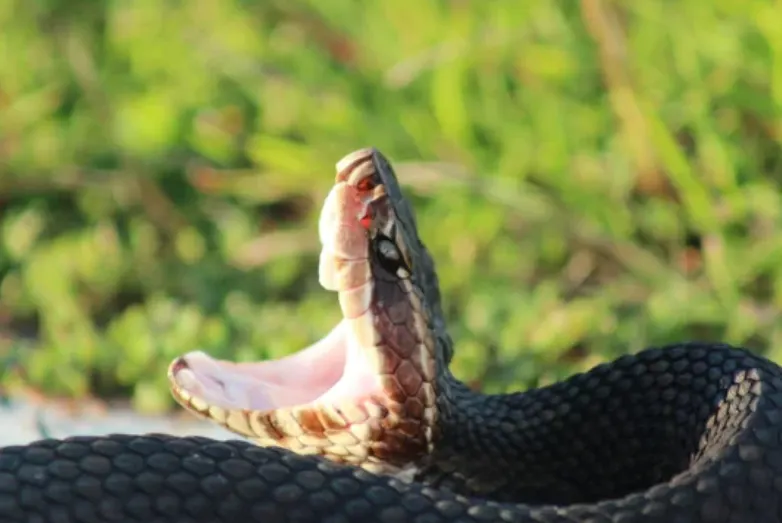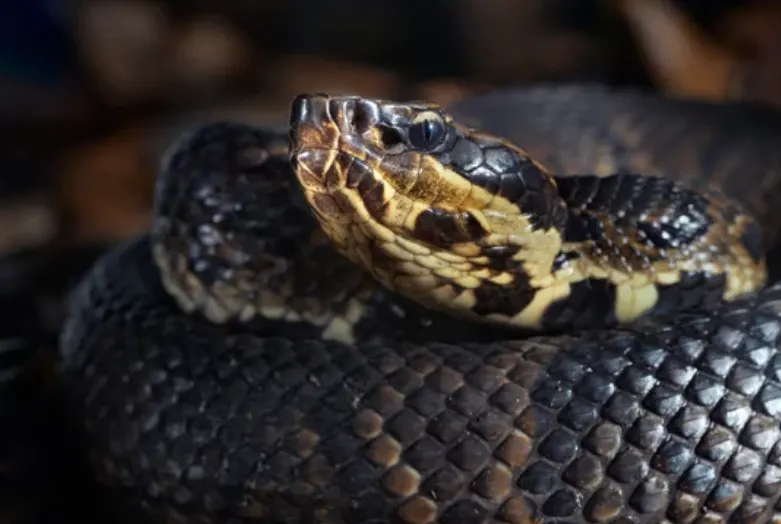The cottonmouth snake, also known as the water moccasin, is a highly venomous reptile native to the southeastern United States. Recognized for its intimidating appearance and potent venom, the cottonmouth has garnered a fearsome reputation. However, this fascinating species is also known for its unique behaviors and adaptations. This guide delves into the cottonmouth’s identification, habitat, diet, and more, providing an in-depth look at one of North America’s most infamous snakes.

Table of Contents
Identification and Physical Characteristics
The cottonmouth (Agkistrodon piscivorus) is easily identifiable by its distinct features. The snake’s large, triangular head and thick, muscular body are characteristic of pit vipers. The cottonmouth’s scales are typically a dark olive or brown, with darker crossbands along the body. These colors provide excellent camouflage in its natural habitat, helping it blend into the muddy waters and underbrush where it often resides.
One of the most striking features of the cottonmouth is the inside of its mouth, which is a bright, cottony white. This distinctive trait is how the snake got its name. When threatened, the cottonmouth will often display this white mouth as a warning to potential predators, a behavior known as “gaping.” This display is usually accompanied by the snake coiling its body and shaking its tail, which can produce a rattling sound similar to that of a rattlesnake.
Habitat and Distribution
Cottonmouths are primarily found in the southeastern United States, ranging from southeastern Virginia to Florida and westward to eastern Texas and Oklahoma. They thrive in wetland habitats, including swamps, marshes, and river floodplains. The snake is also commonly found in ponds, lakes, and slow-moving streams.
What sets the cottonmouth apart from many other snakes is its semi-aquatic nature. Cottonmouths are excellent swimmers and are often seen gliding on the surface of the water with their heads held high. They can be found in both freshwater and brackish environments, making them one of the few snake species comfortable in such a diverse range of aquatic habitats.
Diet and Hunting Behavior
The cottonmouth is a carnivorous predator with a varied diet. It preys on a wide range of animals, including fish, amphibians, birds, and small mammals. Juvenile cottonmouths have a distinctive yellow or greenish tail tip, which they use as a lure to attract prey—a behavior known as caudal luring. They wiggle their tail to mimic the movement of a worm or insect, luring small animals close enough to strike.
Cottonmouths employ both ambush and active hunting strategies. They use their heat-sensing pit organs to detect warm-blooded prey, even in complete darkness. Once they have identified their target, they strike with incredible speed, injecting venom that immobilizes their prey almost instantly. The venom also begins the process of digestion before the snake even swallows its meal, breaking down the prey’s tissues from the inside.
Reproduction and Lifespan
Cottonmouths have a unique reproductive cycle. Unlike many snakes that have a defined breeding season, cottonmouths can mate at any time of the year. However, mating typically peaks in the spring, around April and May. During this time, males will engage in combat dances to win the favor of a female, slithering back and forth and sometimes even physically grappling with rival males.
Female cottonmouths give birth to live young rather than laying eggs, a process known as ovoviviparity. A typical litter consists of five to nine young, although some litters can have as many as 16. The newborns are fully independent from birth and are born with functioning venom glands, ready to hunt from the start. Despite their early self-sufficiency, juvenile cottonmouths have a high mortality rate, with only a few surviving to adulthood due to predation from birds, mammals, and even other snakes.
In the wild, cottonmouths can live up to 10 years, although they have been known to live longer in captivity.
Cottonmouth Venom: Potency and Effects
The cottonmouth’s venom is hemotoxic, meaning it destroys blood cells and tissues. A bite from a cottonmouth can cause severe pain, swelling, and tissue damage, and if left untreated, it can lead to permanent scarring or, in rare cases, amputation of the affected limb. However, fatalities from cottonmouth bites are extremely rare, especially with prompt medical treatment.
It’s important to note that cottonmouths, like many venomous snakes, often deliver “dry bites” when threatened. These bites contain little to no venom and serve as a warning rather than an attempt to kill. This behavior is advantageous for the snake, as venom is metabolically expensive to produce.
Conservation Status and Human Interaction
The cottonmouth is currently listed as a species of “Least Concern” by the International Union for Conservation of Nature (IUCN). Despite the loss of wetland habitats in parts of its range, the cottonmouth remains widespread and relatively common throughout its natural habitat.
In areas where human populations overlap with cottonmouth habitats, encounters are not uncommon. While the snake’s aggressive reputation leads many to fear it, cottonmouths are generally shy and reclusive. They prefer to avoid humans and will only strike if they feel cornered or threatened. Understanding and respecting the cottonmouth’s space is the best way to avoid negative encounters.

Misconceptions and Myths
Cottonmouths are often misunderstood and feared due to a number of myths and misconceptions. One common myth is that cottonmouths will chase humans aggressively. In reality, these snakes are more likely to flee than fight. When they do stand their ground, it’s usually because they feel they have no other option.
Another misconception is that cottonmouths are more dangerous than they actually are. While their venom is potent, it’s less lethal than that of some other North American snakes, such as the coral snake or the eastern diamondback rattlesnake. Most bites occur when people accidentally step on or try to handle the snake, situations that can easily be avoided with caution and awareness.
The cottonmouth is a remarkable species, well-adapted to its semi-aquatic lifestyle and armed with powerful venom. While its fearsome reputation is not entirely undeserved, it is also a highly misunderstood creature. By learning more about the cottonmouth’s behavior, habitat, and ecological role, we can better appreciate this fascinating snake and coexist with it more peacefully.
- Enchi Ball Python: A Unique and Stunning Morph of Python regius - March 27, 2025
- Emerald Tree Monitor: The Enigmatic Green Guardian of the Rainforest - March 26, 2025
- The Egyptian Cobra (Naja haje): A Fascinating Serpent - March 25, 2025
